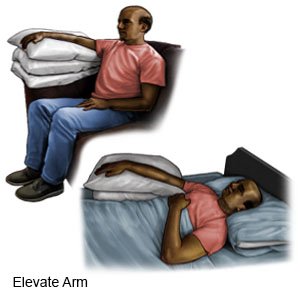Extravasation
Medically reviewed by Drugs.com. Last updated on Aug 4, 2025.
Extravasation is when fluid leaks out of your vein and into the soft tissue around an IV. The fluid is a vesicant medicine. This means that it can cause tissue damage, blisters, or severe tissue loss. Some examples of vesicant medicines include chemo medicines, contrast liquid, certain antibiotics, and seizure medicine.
DISCHARGE INSTRUCTIONS:
Seek care immediately if:
- You have severe pain.
Call your doctor if:
- You have a fever.
- Your pain does not get better, or gets worse.
- The area becomes more red and swollen.
- You see red streaks coming from the area.
- You have questions or concerns about your condition or care.
Medicines:
You may need any of the following:
- Acetaminophen decreases pain and fever. It is available without a doctor's order. Ask how much to take and how often to take it. Follow directions. Read the labels of all other medicines you are using to see if they also contain acetaminophen, or ask your doctor or pharmacist. Acetaminophen can cause liver damage if not taken correctly.
- NSAIDs , such as ibuprofen, help decrease swelling, pain, and fever. This medicine is available with or without a doctor's order. NSAIDs can cause stomach bleeding or kidney problems in certain people. If you take blood thinner medicine, always ask your healthcare provider if NSAIDs are safe for you. Always read the medicine label and follow directions.
- Take your medicine as directed. Contact your healthcare provider if you think your medicine is not helping or if you have side effects. Tell your provider if you are allergic to any medicine. Keep a list of the medicines, vitamins, and herbs you take. Include the amounts, and when and why you take them. Bring the list or the pill bottles to follow-up visits. Carry your medicine list with you in case of an emergency.
Treatment options
The following list of medications are related to or used in the treatment of this condition.
Self-care:
- Continue to apply ice on the area as directed or for 15 to 20 minutes every hour. Use an ice pack, or put crushed ice in a plastic bag. Cover it with a towel. Ice helps prevent tissue damage and decreases swelling and pain.
- Continue to apply heat on the area as directed or for 20 to 30 minutes every 2 hours. Heat helps decrease pain and muscle spasms.
- Continue to elevate the area above the level of your heart as often as you can. This will help decrease swelling and pain. Prop your limb on pillows or blankets to keep it elevated comfortably.

- Ask how to clean the area. Your healthcare provider may bandage the area. He or she may tell you which products you can apply on the area, such as a mild soap.
Follow up with your doctor as directed:
Write down your questions so you remember to ask them during your visits.
© Copyright Merative 2025 Information is for End User's use only and may not be sold, redistributed or otherwise used for commercial purposes.
The above information is an educational aid only. It is not intended as medical advice for individual conditions or treatments. Talk to your doctor, nurse or pharmacist before following any medical regimen to see if it is safe and effective for you.
Further information
Always consult your healthcare provider to ensure the information displayed on this page applies to your personal circumstances.
